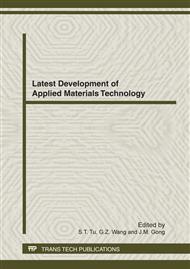[1]
Campbell J. Castings (Second Edition). Oxford: Butterworth-Heinemann, (2003) 205-231.
Google Scholar
[2]
Eskin D G, Suyitno, Katgerman L. Mechanical properties in the semi-solid state and hot tearing of aluminium alloys. Progress in Materials Science, 49(2004) 629-711.
DOI: 10.1016/s0079-6425(03)00037-9
Google Scholar
[3]
Sigworth G K. Hot tearing of steels. Transactions of the American Foundrymen's Society, 104(1996) 1053-1062.
Google Scholar
[4]
Eskin D G, Katgerman L. A Quest for a New Hot Tearing Criterion. Metallurgical and Materials Transactions A, , 38(2007)1511-1519.
DOI: 10.1007/s11661-007-9169-7
Google Scholar
[5]
Campbell J. Castings (Second Edition). Oxford: Butterworth-Heinemann, (2003) 242-258.
Google Scholar
[6]
Feurer U. Quality control of engineering alloys and the role of metals science. (1977) 131-145.
Google Scholar
[7]
Rappaz M, Drezet J, Gremaud M. A new hot-tearing criterion. Metallurgical and Materials Transactions A, , 30(1999) 449-455.
DOI: 10.1007/s11661-999-0334-z
Google Scholar
[8]
Cerri O, Chastel Y, Bellet M. Hot Tearing in Steels During Solidification: Experimental Characterization and Thermomechanical Modeling. ASME Journal of Engineering Materials and Technology , 130(2008)1-7.
DOI: 10.1115/1.2870233
Google Scholar
[9]
Cao G, Kou S. Hot cracking of binary Mg-Al alloy castings. Materials Science and Engineering: A, , 417(2006)230-238.
DOI: 10.1016/j.msea.2005.10.050
Google Scholar
[10]
Hatami N, Babaei R, Dadashzadeh M, et al. Modeling of hot tearing formation during solidification. Journal of Materials Processing Technology , 205(2008)506-513.
DOI: 10.1016/j.jmatprotec.2007.11.260
Google Scholar
[11]
Clyne T W, Davies G J. The Influence of Composition on Solidification Cracking Susceptibility in Binary Alloy Systems. Brit. Found., 74 (1981) 65-73.
Google Scholar
[12]
Campbell J, Clyne T W. Hot tearing in Al-Cu alloys. Cast Metals, 3(1991) 224-226.
DOI: 10.1080/09534962.1990.11819043
Google Scholar
[13]
Clyne T W, Davies G J. A Quantitative solidification Cracking Test for Castings and an Evaluation of Cracking in Al-Mg Alloys. Brit. Found., 68(1975) 238-244.
Google Scholar
[14]
Clyne T W, Davies G J. A comparison of experimental results and theoretical predictions relating to the dependence of solidification cracking on composition. Solidification and Casting of Metals. The Metals Society, (1979) 275-278.
Google Scholar
[15]
Feurer U. Influence of alloys composition and solidification conditions on dendrite arm spacing, feeding and hot tearing properties of aluminum alloys. (1978) 131-145.
Google Scholar
[16]
Ramseyer J C, Gabathuler J P, Feure U, et al. Modellvorstellung und experimenteller Nachweis der Warmrissneigung ternaerer Aluminiumlegierungen. Aluminium, 58(1982)581-585.
Google Scholar


